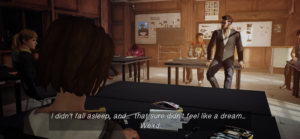Life Is Strange
Life Is Strange was designed by developers Sebastien Gaillard, Sebastien Judit, William Beacham, Baptiste Moisan, and Christopher Sica. The game was published by Square Enix and can be played on various platforms, and I personally played it on my iPhone for this week’s critical play.
Life Is Strange is rated M, so its target audience ranges from older teenagers to young adults interested in interactive storytelling and video games with complex narratives. The incorporation of complex puzzles and occasional use of profanity and violence makes this game less suitable for younger children.

Analysis of Formal Elements + Types of Fun
- Mysterious Opening Atmosphere: The opening scene depicts the main character, Max, who wakes up in a forest in the middle of a destructive storm. Given Max’s confusion and lack of knowledge about where she is, the narrative immediately starts off with a sense of urgency and mystery that continues to unfold throughout the game as the player tries to decode where she is and what is going on. The player also gets to take on the role of Max which offers the player a more immersive experience shaped by fantasy.
- Time Travel + Choices: Max discovers her ability to rewind time, and this power allows the player to gather clues and investigate the mysteries of Arcadia Bay, encouraging discovery. Going back in time, the player can also make choices that alter the storyline’s course of events, and this player autonomy allows for a more meaningful, personalized experience that increases engagement, investment, and expression.
- Exploration + Interactions: As the player explores this mysterious world as Max, they are encouraged to decipher the mystery by uncovering clues, discovering collectibles, and interacting with characters. The order in which these discoveries and interactions occur can influence the overall narrative and keeps the mystery and game unpredictable for the player.
Loops + Arcs
Every episode of Life Is Strange has its own individual narrative arc, with its own loops that contribute to the mystery of the overarching narrative. For example, some of these loops result from Max’s ability to rewind time; players can revisit the same moments but make different choices which lead to different outcomes. These smaller episode arcs are powerfully nested and contribute to the rich narrative structure of the game’s larger arc.

Conclusion + Improvements
Overall, I found time travel to be a unique game mechanic and an innovative way to allow users to explore different choices and outcomes. The narrative is also beautifully crafted with mystery and complex themes such as friendship as the player interacts with other characters. However, there were quite a few bugs in the iOS App Store version of the game that interfered with my gameplay. There were multiple instances where I got stuck viewing the journal or other artifacts because the exit and navigation buttons were outside of my screen frame. Otherwise, I personally would like the pacing to move faster; it would be helpful if players had the option to view the game on 2x speed.



